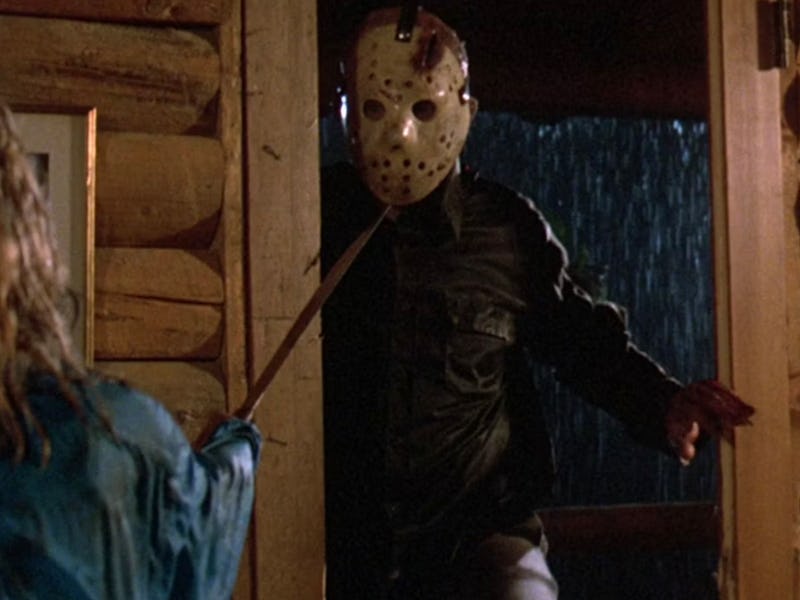The Most Underrated Friday the 13th Sequel Is The Pinnacle of the ‘80s Slasher
The intended final chapter of Jason Voorhees’ story embodied the best of the franchise.

In the public imagination, major aspects of the Friday the 13th franchise tend to appear kind of nebulous. In the first movie, Jason Voorhees doesn’t actually kill anyone — it’s the work of his vengeful mother. Jason will forever be linked to his iconic hockey mask, but that doesn’t actually show up until Part III. And while everyone thinks of him as virtually unkillable, he doesn’t become an indestructible zombie until Part VI. So when it comes to finding a Friday the 13th movie that embodies not only everything fun about the series but also all the trademarks that people associate with it, it’s a little difficult. That said, the fourth entry, Friday the 13th: The Final Chapter, is the closest (and best) that you’re gonna get.
By 1984, Jason Vorhees had handily stolen the crown of the ultimate slasher bad guy from Michael Myers, who was left as a pile of ashes at the end of Halloween II and wouldn’t be back for a while. Freddy Krueger and the first Nightmare on Elm Street wouldn’t show up until later in the year, poor Leatherface wouldn’t get a comeback tour for two more years, and Chucky and Pinhead only debuted in the final gasp of the ‘80s. As such, Friday the 13th was left to reign supreme and accumulated sequel after sequel (nearly one a year) since 1980.
Of course, by now, you’ve noticed that the title of the fourth film is “The Final Chapter,” a grand misnomer. A Part V would be out in theaters less than a year after it, and even Part III was originally intended as the “final chapter.” But if there is any Friday the 13th film that could serve as a real ending, it is, indeed, The Final Chapter. It’s a film that, even among the early stages of slasher movie malaise, manages to combine and indulge in everything that makes it a hoot. It’s a throw-every-body-part-at-the-wall-and-see-what-sticks finale.
A lot of this quality comes from the fact that it had the benefit of a good director, a good cast, and stellar make-up effects. Joseph Zito, at that point having helmed the extremely underrated The Prowler, was chosen to lead The Final Chapter. He has the rare slasher movie gift of being able to balance the necessary suspenseful thrills with the kind of morbid curiosity that drives these flicks — deep down inside, we want to see the different, increasingly creative ways that these obnoxious teens can get mangled. As such, The Final Chapter never plays like a comedy, but it does take down its cast with a smirk of horror one-upmanship.
Jason Voorhees is finally the killer we know and love in The Final Chapter.
Those obnoxious teens are the most memorable in the series outside of perennial movie trivia facts like Kevin Bacon’s role in the first film. A lot of that is owed to a solid supporting turn by Crispin Glover, still on his way to becoming the patron saint of Hollywood eccentricity and perfect as the shy, bizarre Jimmy. There are few moments in slasher films that match the “Wait, what am I watching?” feeling of his impromptu dance scene, and it helps build a little odd sympathy for him before he takes a cleaver to the skull.
That cleaver to the skull or that neck broken or that head crushed in the shower all look great thanks to the real star of the film: Tom Savini’s make-up work. Savini had revolutionized the slasher film and after taking part in classics like George Romero’s Dawn of the Dead and the first Friday the 13th, he’d gone on to rule over it as his slaughterhouse fiefdom. By the time he looped back around to (attempt to) kill off the franchise he’d helped kickstart with The Final Chapter, he’d added Maniac, The Burning, The Prowler, Creepshow and Alone in the Dark to his resume. He didn’t manage to terminate Jason (no one has,) but he did manage to become the most famous name in horror make-up since Jack Pierce’s work on the Universal monsters.
The makeup by Tom Savini puts The Final Chapter above the rest.
Though The Final Chapter didn’t end things, it certainly set things in motion to wrap up Jason’s story. Among the cast is Tommy Jarvis, played by a young Corey Feldman, a child that also happens to be a horror make-up effects devotee. It isn’t hard to see where he gets the inspiration for his name but he also represents a new wave of slasher fan, the kind that would’ve grown up watching Friday the 13th and idolizing men like Savini. He’s the one that lands the “killing” blow on Jason, putting the series into his hands and metaphorically placing the horror genre into the grip of a new generation, the one that came of age during Michael, Jason, Freddy, and their gruesome ilk.
Of course, Jarvis’ stint as the leading man of Friday the 13th wouldn’t last. He’d show up in a Jason-less Part V and stick around to see the villain’s resurrection in Part VI (played by different actors in both) before the series moved on. It would never quite return to the gory pinnacle of The Final Chapter, even as it continued to up the ante on its kill counts and buckets of blood. But the most renowned slasher films are rarely marked by the intricacy of the slayings or the interest in the cast or the sheer effortlessness of the direction. Instead, their reputation comes from how all of these things are mixed together and then splattered, oozing and dripping red, on the screen.